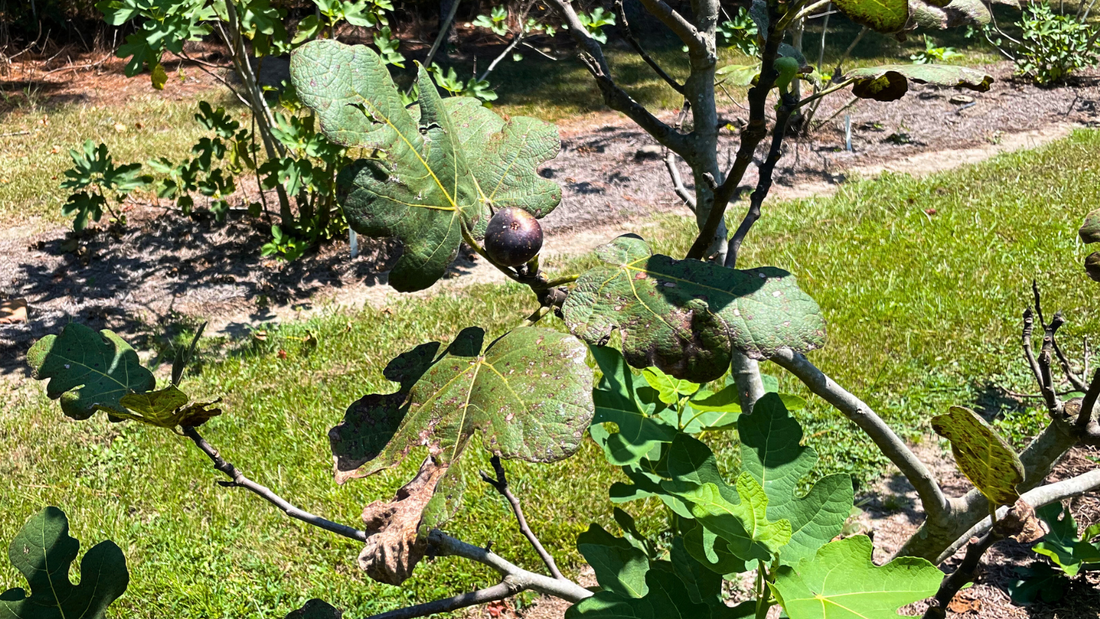Have you ever seen brown spots on your fig tree leaves in the middle of summer? If you're new to growing fig trees, you might have been worried that your fig tree was sick or dying. In this blog we'll explain what causes those brown spots and present some solutions for reducing them.
What is Fig Rust?
Fig rust is a disease caused by the fungus Cerotelium fici. It is spread via airborne spores from infected leaves. Those spores can be transferred via wind or water splashing onto your fig tree.
The fungi will overwinter in areas with milder winter temperatures. Once the temperates warm in spring and summer, it's ready to infect your trees again. Much like other fungal diseases that infect plants, fig rust is worst when the temperatures are the hottest.
Although any fig tree can get it, it's more common in the southern states where temperatures are warm and humid. Here in south Georgia, fig rust is a fact of life. It's not a matter of whether a tree is going to get it, just a matter of when. We see it every year on all our trees, but it's nothing that should worry you too much.
3 Signs of Fig Rust
How do you know that you have fig rust and not some other problematic fruit tree disease? Below we've listed three easy signs to know it's rust.
1. Leaf Spots
Rust will begin to manifest itself as tiny yellow or brown spots on the leaves of your fig tree. As temperatures continue to warm in the summer, these spots can become more prevalent and larger. The leaves of your tree will look like something that's rusting, hence the name "fig rust."

2. Leaf Deformation
Once rust is fully developed on the leaves of your fig tree, you'll notice that some of the leaves start to become deformed. The leaves may curl or become dry and brittle. This is part of the natural progression of the fungus.

3. Leaf Drop
Once the leaves become covered with rust, brittle, and deformed, the tree will usually lose those leaves. Our fig trees do this every summer and are bare without leaves for a few weeks during the heat of summer. But don't fret, the tree will grow more leaves and be just fine!

How to Stop Fig Rust
As mentioned above, fig rust is as inevitable as death and taxes here in the deep south. It can be mitigated, but rarely are we going to see a season without any rust on our trees. Here are some things you can do to reduce the amount of rust on your trees.
1. Dormant Spray
I don't recommend spraying fig trees while they have figs on them, but you can spray trees in the dormant season and in the spring before fruit production begins. We like to spray ours with a fungicide in the late winter months before leaves develop, and again during initial leaf development before figs start forming.
There are a variety of products you can use for a fig tree fungicide. These include neem oil, mineral oil, copper fungicides, or fungicides that use beneficial bacteria. We like to use a liquid copper fungicide and our BugHut plant booster as we've found it to be more effective on our trees. We also have to be careful spraying neem oil because it can burn the leaves if it's too hot outside.
2. Improving Air Circulation
As fig trees grow, they can become quite bushy and dense with leaves all over the tree. This creates a moist, humid environment for a fungus like fig rust to thrive, but this can be mitigated by pruning the tree to improve air circulation.
Pruning should be done in the late fall or early winter months when your fig trees have lost all their leaves and entered their dormant phase. It's hard to "overprune" a fig tree, so be as aggressive as you'd like. The better the air flow amongst the inner branches, the fewer rust problems you should have.
3. Reducing Leaf Moisture
We're big believers in drip irrigation in our fig orchard for a myriad of reasons. It helps our trees grow faster and it conserves a significant amount of water compared to overhead irrigation. It also makes watering easy because you just turn it on and let it run.
Drip irrigation can also help with fungal diseases on fig trees because it reduces the amount of leaf moisture on your trees. Obviously you can't do anything about a rainy season, but you can reduce leaf moisture by watering your trees at the roots. Try to reduce the amount of leaf moisture and the amount of rust should be reduced as well.
4. Removing Old Plant Debris
Proper sanitation around the base of your trees can also help reduce the amount of fig rust you might have. If your tree is losing leaves due to fig rust, try to remove those leaves from around the base of the tree. And as trees lose their leaves in the fall, blow or rake the fallen leaves from the base of the tree. This will help reduce the amount of fungal spores you have sitting at the base of your trees.
Should You Be Concerned?
Some growers get very concerned about fig rust and claim that it hurts their fig production and the growth of their trees. But we don't worry about it much at all. We know it's going to happen every year in our climate, and there's no way for us to eliminate it completely. We will use some of the tactics above to reduce the presence of it somewhat, but we know fig rust will eventually appear in the middle of summer.
I haven't found that our yearly bout of mid-summer fig rust has any effect on our fig production. Rust usually comes after the initial main crop of figs on our trees, and doesn't appear to inhibit anything with that first main crop. It's part of natural cycle down here that we see every year in our fig orchard.
I've talked to other fig growers in the southern states and they actually believe that rust helps promote more new growth on the fig trees. When the rusted leaves fall in mid-summer, the tree puts on a new set of leaves and starts growing more in late summer and fall. This results in more new growth and a second main crop of figs for us. So if you have a long growing season, rust may not be a bad thing at all!

